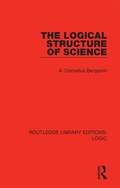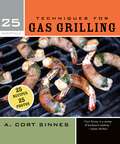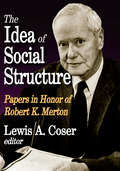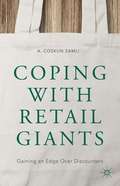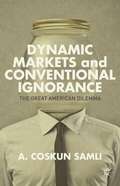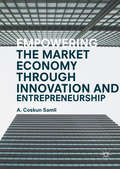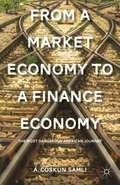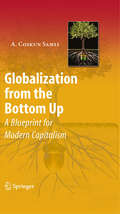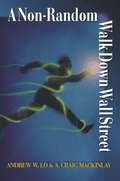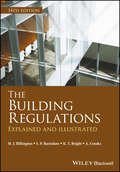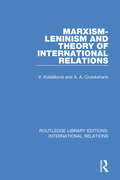- Table View
- List View
IR: Seeking Security, Prosperity, and Quality of Life in a Changing World
by James M. Scott Yasemin Akbaba Ralph G. Carter A. Cooper DruryIR: Seeking Security, Prosperity, and Quality of Life in a Changing World presents a comprehensive approach to understanding world politics through the lens of security, prosperity, and quality of life in a rapidly evolving global environment. The book not only acquaints students with events, but also broadens the context to analyze larger patterns, making the experience immersive and engaging. Thoroughly updated, the Fifth Edition incorporates new theoretical perspectives, coverage of important events and trends of recent years, and current data and research.
The Logical Structure of Science (Routledge Library Editions: Logic)
by A. Cornelius BenjaminThis book addresses the argument in the history of the philosophy of science between the positivists and the anti-positivists. The author starts from a point of firm conviction that all science and philosophy must start with the given… But that the range of the given is not definite. He begins with an examination of science from the outside and then the inside, explaining his position on metaphysics and attempts to formulate the character of operational acts before a general theory of symbolism is explored. The last five chapters constitute a treatise to show that the development from one stage of symbolismto the next is inevitable, consequently that explanatory science represents the culmination of knowledge.
25 Essentials: Every Technique Paired with a Recipe (25 Essentials)
by A. Cort SinnesMaster of backyard cooking A. Cort Sinnes presents 25 sure-fire techniques for cooking with a wood-fired oven, each introduced by a delectable, smoke-infused recipe—including breads and pizzas, fish, poultry, meats, vegetables, and sides. Mouthwatering photography with every recipe provides incentive to fire up. Succulent, smoky, and sublime. Wood-fired ovens are all about enjoyment: enjoying the process of cooking with them and enjoying the deeply flavorful results. This essential guide to cooking with both white and black fire ovens teaches you to embrace and master the unpredictability of wood-fired cooking. An introduction provides the basics of cooking in a wood-fired oven, including the types of ovens available, general guidelines, cooking temperatures and times, a guide to what accessories to have on hand, and tips on safety. Then move right on to impressing your guests with these amazing dishes and more: ·Pizza Bianca ·Swordfish Fillets Wrapped in Prosciutto ·Whole Roasted Butterflied Turkey ·Cowboy Steak with Whiskey Sauce ·Smashed New Potatoes with Miso MayonnaiseTurn your wood-fired oven into an indispensable tool in your outdoor cooking arsenal with this must-have reference.
25 Essentials: Techniques for Gas Grilling
by A. Cort SinnesGas grills are easy, convenient, and clean. But the challenge, for new owners and even for seasoned vets, is to infuse the robust, soulful flavor of charcoal-grilled food, or, ideally, of smoke-cooked barbecue, into meals cooked on a gas grill. In 25 Essentials: Techniques for Gas Grilling, A. Cort Sinnes, author of the bestselling The New Gas Grill Gourmet, shows how to do just that. Built around 25 techniques, each exemplified with a tempting recipe and a handsome color photo, this is a competitively priced, gift-appropriate title, sure to improve the backyard cooking skills of any gas-grill owner. Front matter addresses how to choose, maintain, accessorize, and use a gas grill, and the 25 recipes cover beef, lamb, pork, chicken, fish, and vegetarian options. The techniques include foil-packet grilling, how to grill delicate fish, grilling sliced vegetables, and 22 more.
The Idea of Social Structure: Papers in Honor of Robert K. Merton
by A. Coser LewisWritten and compiled by friends and former students, The Idea of Social Structure honors Robert K. Merton, considered one of the premier sociologists of the twentieth century. Along with Talcott Parsons and Marion J. Levy, Merton was emphatic in his use of the term "social structure"—however different they were in defining and refining the term. The chapters in this volume address many of Merton's diverse sociological theories and, in turn, his theories' impact upon a very large sociological territory.The volume includes major statements on the context of working with Merton by Lewis A. Coser, Paul F. Lazarsfeld, Robert A. Nisbet, and Seymour Martin Lipset, as well as memorable statements covering Merton's interests in the sociology of knowledge and science, planning communities, medical education, relative deprivation, everyday life, political roles, and communication media. This is a powerful sourcebook for understanding the work of Merton and of his intellectual successors.Nisbet called the decade of the 1930s among the most vital and creative periods in American history. It was certainly a period of intense struggle—political, military, and ideological. But the formation of modern sociology was without question one of the crowning achievements in the scientific evolution of the century. The volume is sharply focused on Merton's work and deeply appreciative of the nature of his contribution. It is a landmark effort in the study of sociology as history.
Coping with Retail Giants
by A. Coskun SamliIn the retail jungle dominated by giants like Walmart and Costco, survival for small and medium sized retailers will require a major shift from the traditional strategy of merchandise management to focus on generating customer value. Coping with Retail Giants critically analyzes the modern retail market and identifies how businesses gain the competitive edge over the major retailers that currently control the market. Samli argues that as society advances economically, consumers will seek better values generated by the retailing sector. This powerful stimulus will accelerate the retail revolution and be primarily carried out by entrepreneurial retailers-managers in small and medium sized retailing. Samli blends retail theory and practice to present a new model for retailing that delivers customer value, and ultimately, retail success.
Dynamic Markets and Conventional Ignorance
by A. Coskun SamliA market economy is the only mechanism that can create jobs, distribute wealth, spur economic growth, and stabilize the economy for all. However, the current American market economy is not working - it is helping the "1%" instead of distributing wealth and yet simultaneously convincing the "99%" that this market is the only way to create jobs. The current unchecked system allows those wealthy few to "steal the American dream," as Hedrick Smith claimed. In order for the United States to grow the economy, the current system must first be modified to level the playing field, and then must be used to develop the market system's originally intended purpose: improving the quality of life for all. In this follow up to From a Market Economy to a Finance Economy, Samli reflects on his more than half a century of economic experience and research, maintaining that financiers, the government, and many decision makers in both politics and the economy, do not really support the "free market. " He puts forth key ideas for using the market mechanism correctly to benefit all Americans.
Empowering the Market Economy through Innovation and Entrepreneurship
by A. Coskun SamliThis book argues that the strength of our dynamic society is a market economy, which functions well only if positive and constructive marketing practices are performed. It offers innovative alternatives for achieving economic progress and outlines strategies to create conditions for equal opportunity. The American economy has transitioned from a "survival of the fittest" to "survival of the fattest" mentality, focusing less on the people and quality of life and more on the amount of dollars to be gained. The divide between the 1% and 99% leaves lower-income individuals at a significant disadvantage and threatens both economic and societal advancement. The author offers clear, intelligible solutions to accomplish this such as eliminating discrimination, providing opportunities for new ideas and industries, enhancing quality of life, and encouraging more competition so that radical innovations can emerge and make a positive difference. This book will appeal to leaders and researchers across marketing, economics, management, and accounting looking for answers on how to get the American economy back on track.
From Imagination to Innovation
by A. Coskun SamliIt is impossible to measure the full economic and psychological benefits of the sewing machine, the polio vaccine, or the Internet. What we know is that these products have changed our lives for the better, generating net benefits well beyond the metric of corporate profits. As forces such as financial market volatility and fragmented markets demonstrate the fragility of the global economy, the imperative to develop products and services that contribute to the well-being of the many--rather than the few--is more pronounced than ever. In this book, A. Coskun Samli explores this imperative of an "innovation culture" and how it can be encouraged at all levels, from the individual to the nation or region. He argues that without a global innovation culture, committed to generating socially valuable products, we are likely to face a deteriorating quality of life, as wealth is concentrated at the top. Integrating insights from management, economics, policy, and psychology, Samli demonstrates how creativity can be channeled into innovation and innovation can be channeled, in turn, toward economic development. He discusses how national policies can be oriented toward encouraging such socially beneficial innovations as sustainable energy, communication technology, and medical discoveries. The aim is to promote the development of products and services that improve quality of life and generate profits for those who invest in them. He argues that all innovations, whether radical or incremental, must demonstrate social value in order to be truly profitable.
From a Market Economy to a Finance Economy
by A. Coskun SamliIn this gripping book, Dr. Samli makes the case that the US economy is shifting for the worse, tilting towards a finance-driven economy, and argues that investing in innovation will bring us out of the recession and back to a successful, market-driven economy.
Globalization from the Bottom Up
by A. Coskun SamliTakes a proactive approach to addressing big issues of world poverty, economic development, and the impact of globalization -- with recommendations for business leaders, policymakers, and concerned citizens around the world Samli offers an alternative model, a philosophy and practice of "social capitalism" that is grounded in a bottom-up approach to wealth creation, while acknowledging that power will continue to be concentrated at the top level of the pyramid
Infrastructuring
by A. Coskun SamliThe recent global financial crisis has intensified concerns over how nations--both developed and developing -- can revitalize economic growth and ensure opportunity for prosperity to all citizens. Many analysts and policymakers alike are looking to new business creation and the promotion of entrepreneurial practices as a panacea, or at least as a partial solution. A. Coskun Samli has argued in his two most recent books that the current model of globalization tends to marginalize the poor and that developing countries must rely on local business development, rather than exogenous forces, such as aid, loans, and trade, to catalyze growth. This third book in his trilogy argues that a "bottom-up" approach is necessary for developing countries to participate in globalization--but is not sufficient. He proposes that the economic goals of a country, a region, or a company are fulfilled first and foremost by a properly designed and maintained infrastructure, encompassing both physical elements, such as transportation and communication systems, and qualitative elements, such as functioning educational, legal, and governing institutions. In Infrastructuring, Samli analyzes the experiences of a variety of countries, including China, India, Ireland, and South Africa, to highlight the role that infrastructure plays in economic development, and considers its implications for such timely issues as new business creation, productivity, and supply chain logistics. Moreover, he outlines practical approaches to infrastructure management and policy oversight.
International Consumer Behavior in the 21st Century
by A. Coskun SamliOver the past two decades, the face of the world consumer has truly changed. Goods are more available, information about these goods is more open and accessible, and the ability to buy these goods from any corner of the earth has become possible. As a result, international marketing is more important now than ever before. In this book, Josh Samli explores the challenges facing modern international marketers. He explains what it is to have successful communication with the target market: using social media to share consistent information about products and services, communicating directly with culture-driven consumers who already communicate online amongst themselves and with competitors, and mastering people-to-people communication with both privileged and non-privileged consumers. Any company dealing with international marketing must learn how to handle these new challenges in order to survive in the 21st century.
International Entrepreneurship
by A. Coskun SamliDespite the accelerating pace of globalization, it is impossible to ignore the marginalization of the developing world, as billions of people continue to slip deeper into poverty. While many theories, policies, and practices have been proposed to help redress the disparities between the "haves" and the "have-nots," only recently have proponents of sustainable economic development and entrepreneurship discovered each other. In this provocative and timely book, A. Coskun Samli fills the gap by making the connections explicit and arguing that entrepreneurship may be the only hope for countries that have fallen into the trap of relying on foreign aid and bowing to the pressures of multinational conglomerates driven by short-term profit-maximizing goals. Samli builds the case that some cultures are more entrepreneurial than others, and demonstrates the importance of creating the right conditions, infrastructure, policies, and educational systems that inspire and support new business creation.
Who Stole Our Market Economy?
by A. Coskun SamliThis book discusses the current landscape of our market economy, which is in the hands of financiers and billionaires who decrease competition as well as consumer power. In order for society to fully thrive and provide its members higher living standards and quality of life, it must distribute and deliver the fruits of the economic activity without discrimination and favoritism. This book exposes the real problem of economic inequality, poverty, and the elimination of the middle class and argues for a progressive market economy in the face of regressive conservatism. The author warns of business failures, rigid and unrealistic laws, widespread unemployment, and class warfare without a fair, functional system. Until action is taken to reverse this situation, our market economy will continue to be abused by the greedy and the powerful, stripping it of any potential for advancement and growth.
Macroprudential Policy: What Instruments and How to Use Them?1
by C. Lim F. Columba A. Costa P. Kongsamut A. Otani M. Saiyid T. Wezel X. WuA report from the International Monetary Fund.
Control of Crop Diseases
by W. R. Carlile A. CoulesThoroughly revised and updated to reflect current and emerging practices, this book explores modern methods of disease control in field and glasshouse crops. It outlines the major crop diseases, with a particular emphasis on those features of symptomology and life cycle that are most relevant to the development of control measures. Modern diagnostic techniques are considered, focusing on developments in nucleic acid and immunological based procedures and their use in plant quarantine and certification schemes. The potential impact of these advances in molecular technology on plant breeding and disease resistance is also covered. Fungicides are a central part of disease control in the EU and, as such, a comprehensive account of their use forms an important part of the text, along with strategies to minimise the incidence of fungicide resistance in pathogen populations. Looking to the future, the book also addresses legislative, environmental and food safety concerns.
Metal Men: Marc Rich and the $10 Billion Scam
by A. Craig CopetasThis true story of the multibillionaire who fled to Switzerland &“reads like a mystery novel&” (USA Today). How did Marc Rich make over ten billion dollars while paying hardly any taxes? Journalist A. Craig Copetas infiltrated the inner circle of the commodities market and Rich&’s associates to show not only how the metals and minerals trader pulled off the scam, becoming one of America&’s most wanted criminals, but also how other traders have used the same model to evade taxes as well. A continuing figure of controversy even after his death, Rich, a hedge fund manager and the founder of Glencore, was wanted for evading almost ninety million dollars in taxes and if caught, could have spent life in prison. From a former staff reporter at The Wall Street Journal, Metal Men is a story of international intrigue spanning the globe, from the inside of the White House to the Kremlin, a brilliantly researched work that exposes the inner workings of one of country&’s largest scams. &“Mr. Copetas is at his best evoking the high-stakes, fast-paced life of the commodities traders: the greed and corruption that consume them are the stuff of high drama.&” —The New York Times Book Review
A Non-Random Walk Down Wall Street
by Andrew W. Lo A. Craig MacKinlayFor over half a century, financial experts have regarded the movements of markets as a random walk--unpredictable meanderings akin to a drunkard's unsteady gait--and this hypothesis has become a cornerstone of modern financial economics and many investment strategies. Here Andrew W. Lo and A. Craig MacKinlay put the Random Walk Hypothesis to the test. In this volume, which elegantly integrates their most important articles, Lo and MacKinlay find that markets are not completely random after all, and that predictable components do exist in recent stock and bond returns. Their book provides a state-of-the-art account of the techniques for detecting predictabilities and evaluating their statistical and economic significance, and offers a tantalizing glimpse into the financial technologies of the future. The articles track the exciting course of Lo and MacKinlay's research on the predictability of stock prices from their early work on rejecting random walks in short-horizon returns to their analysis of long-term memory in stock market prices. A particular highlight is their now-famous inquiry into the pitfalls of "data-snooping biases" that have arisen from the widespread use of the same historical databases for discovering anomalies and developing seemingly profitable investment strategies. This book invites scholars to reconsider the Random Walk Hypothesis, and, by carefully documenting the presence of predictable components in the stock market, also directs investment professionals toward superior long-term investment returns through disciplined active investment management.
The Econometrics of Financial Markets
by John Y. Campbell Andrew W. Lo A. Craig MacKinlayThe past twenty years have seen an extraordinary growth in the use of quantitative methods in financial markets. Finance professionals now routinely use sophisticated statistical techniques in portfolio management, proprietary trading, risk management, financial consulting, and securities regulation. This graduate-level textbook is intended for PhD students, advanced MBA students, and industry professionals interested in the econometrics of financial modeling. The book covers the entire spectrum of empirical finance, including: the predictability of asset returns, tests of the Random Walk Hypothesis, the microstructure of securities markets, event analysis, the Capital Asset Pricing Model and the Arbitrage Pricing Theory, the term structure of interest rates, dynamic models of economic equilibrium, and nonlinear financial models such as ARCH, neural networks, statistical fractals, and chaos theory. Each chapter develops statistical techniques within the context of a particular financial application. This exciting new text contains a unique and accessible combination of theory and practice, bringing state-of-the-art statistical techniques to the forefront of financial applications. Each chapter also includes a discussion of recent empirical evidence, for example, the rejection of the Random Walk Hypothesis, as well as problems designed to help readers incorporate what they have read into their own applications.
Heroic Fantasy Short Stories (Gothic Fantasy)
by Zach Chapman Michael Haynes Kate O'Connor Lauren C. Teffeau Tony Pi Alexandra Renwick M. Elizabeth Ticknor Susan Murrie Macdonald Voss Foster Beth Dawkins A. Creg Peters Therese Arkenberg Erin Gitchell David Busboom Amy Power Jansen Joanna Michal HoytNew authors and collections. Somewhere between epic historical fantasy, sword and sorcery and Tolkien-esque fantasy exists a thick vein of storytelling that would make Robert E Howard and H.G. Wells proud. Following the great success of our Gothic Fantasy, deluxe edition short story compilations, Ghosts, Horror, Science Fiction, Murder Mayhem and Crime & Mystery we present a compilation of savage swordplay, and high magic, of daring deeds and gaudy battles, in a blazing mix of classic and brand new writing, with authors from the US, Canada, and the UK.Classic authors include: Clark Ashton Smith, John Buchan, Snorri Sturluson, Homer, A. Merritt, Geoffrey Chaucer, Andrew Lang, Howard Pyle, William Morris, Eric Rücker Eddison, with the text of Sir Gawain and the Green Knight and extracts from Beowulf, The Nibelungenlied and The Song of Roland.
The Building Regulations: Explained and Illustrated
by M. J. Billington A. Crooks K. T. Bright S. P. BarnshawSince publication of the first edition in 1976, The Building Regulations: Explained and Illustrated has provided a detailed, authoritative, highly illustrated and accessible guide to the regulations that must be adhered to when constructing, altering or extending a building in England and Wales. This latest edition has been fully revised throughout. Much of the content has been completely rewritten to cover the substantial changes to the Regulations since publication of the 13th edition, to ensure it continues to provide the detailed guidance needed by all those concerned with building work, including architects, building control officers, Approved Inspectors, Competent Persons, building surveyors, engineers, contractors and students in the relevant disciplines.
Marxism-Leninism and the Theory of International Relations (Routledge Library Editions: International Relations #4)
by V. Kubalkova A. CruickshankRefuting the assumption that orthodox Marxist theory contains anything of relevance on international relations, this book, originally published in 1980, clarifies, reconstructs, and summarizes the theories of international relations of Marx and Engels, Lenin, Stalin and the Soviet leadership of the 1970s. These are subjected to a comparative analysis and their relative integrity is examined both against one another and against selected Western theories. Marxist-Leninist models of international relations are fully explored, enabling the reader to appreciate the essence and evolution of fundamental Soviet concepts as such as proletarian, socialist internationalism, peaceful co-existence, national liberation movement and détente.
Topics on the Dynamics of Civil Structures, Volume 1
by Paul Reynolds A. Cunha K. Salyards V. Racic F. N. Catbas J. M. CaicedoTopics on the Dynamics of Civil Structures, Volume 1, Proceedings of the 30th IMAC, A Conference and Exposition on Structural Dynamics, 2012, the first volume of six from the Conference, brings together 45 contributions to this important area of research and engineering. The collection presents early findings and case studies on fundamental and applied aspects of Structural Dynamics, including papers on: Human Induced Vibrations Bridge Dynamics Operational Modal Analysis Experimental Techniques and Modeling for Civil Structures System Identification for Civil Structures Method and Technologies for Bridge Monitoring Damage Detection for Civil Structures Structural Modeling Vibration Control Method and Approaches for Civil Structures Modal Testing of Civil Structures
Topics on the Dynamics of Civil Structures, Volume 1: Proceedings of the 30th IMAC, A Conference on Structural Dynamics, 2012
by A. Cunha K. Salyards V. Racic F. N. Catbas J. M. Caicedo P. ReynoldsTopics on the Dynamics of Civil Structures, Volume 1, Proceedings of the 30th IMAC, A Conference and Exposition on Structural Dynamics, 2012, the first volume of six from the Conference, brings together 45 contributions to this important area of research and engineering. The collection presents early findings and case studies on fundamental and applied aspects of Structural Dynamics, including papers on: Human Induced Vibrations Bridge Dynamics Operational Modal Analysis Experimental Techniques and Modeling for Civil Structures System Identification for Civil Structures Method and Technologies for Bridge Monitoring Damage Detection for Civil Structures Structural Modeling Vibration Control Method and Approaches for Civil Structures Modal Testing of Civil Structures.

